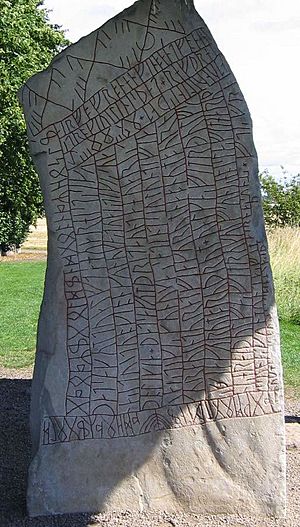Old Norse language facts for kids
Quick facts for kids Old Norse |
||||
|---|---|---|---|---|
| Dǫnsk tunga ("Danish tongue") Norrœnt mál ("Norse speech") |
||||
| Native to | Scandinavia | |||
| Region | Nordic countries, Great Britain, Ireland, Isle of Man, Normandy, Newfoundland, the Volga and places in-between | |||
| Era | developed into the various North Germanic languages by the 14th century | |||
| Language family |
Indo-European
|
|||
| Early forms: |
Proto-Indo-European
|
|||
| Writing system | Runic, later Latin (Old Norse alphabet) | |||
|
||||

Old Norse was a language spoken in Scandinavia during the exciting Viking Age. This was from about the 8th century until the 14th century. It was the language of the famous Vikings and their sagas.
People also spoke Old Norse in places where the Scandinavians settled. These places included Iceland, the Faeroe Islands, and the Orkney Islands. It was like the main language for a large part of northern Europe.
Contents
What is Old Norse?
Old Norse is a type of Germanic language. This means it belongs to the same language family as English and German. It developed from an even older language called Proto-Norse.
Over time, Old Norse changed and split into different dialects. These dialects were spoken in different parts of the Norse world. The main ones were Old West Norse and Old East Norse.
Where was Old Norse spoken?
Old Norse was spoken across a wide area. Its home was in the Nordic countries like Norway, Sweden, and Denmark. But the Vikings traveled a lot.
They took their language with them to new lands. This included parts of Great Britain, Ireland, and the Isle of Man. They even reached Normandy in France and Newfoundland in North America.
How did Old Norse change?
Old Norse slowly changed into the languages we know today. By the 14th century, it had developed into the modern North Germanic languages. These languages are still spoken in the Nordic countries.
Modern Icelandic is the language that is most like Old Norse. If you can read Old Norse, you can often understand written Icelandic. Another language that is very close is Elfdalian, spoken in a small part of Sweden.
Other languages that came from Old Norse include Swedish, Danish, Faroese, and Norwegian. They have changed more over time.
Why is Old Norse important?
Old Norse is important because it gives us a look into the past. Many old stories and poems were written in Old Norse. These include the famous Norse sagas and Eddas. They tell us about Viking heroes, gods, and their adventures.
The earliest form of writing in Old Norse used runes. These were special symbols carved into stone or wood. Later, people started using the Latin alphabet, which is what we use today.
See also
 In Spanish: Nórdico antiguo para niños
In Spanish: Nórdico antiguo para niños

